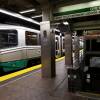The MBTA's Orange Line makes stops at Boston's two community college campuses in Roxbury and Charlestown, so the September shutdown of the train line was a blow to student commuters like Kiara Rosario.
"I do not have a car. I do need this transportation,” she said, standing in the heat at a temporary shuttle bus stop on Columbus Avenue at Roxbury Community College on a recent September morning.
The 34-year-old single mom is studying to be a social worker, while working part-time at a grocery store and raising a five-year-old child with a disability. Waiting for a shuttle that has an open seat has added about a half hour to her commute, and strained her ability to get where she needs to go on time, but without a car she has no other option.
Transportation is a problem for many community college students. According to research, 20 percent of community and technical colleges campuses in New England are not easily accessible by public transportation at all.
The Seldin/Haring-SmithFoundation in Washington, D.C. mapped the presence and proximity of public transit stops to community colleges throughout the U.S. by state and region, and the results showed that some of Massachusetts' community colleges don't even have local bus service.
"It depends on where you attend college,” said chief executive Abigail Seldin. “Up until the Orange Line stoppage, many students who lived and worked along the Orange Line did not need a car to attend college. When you move away from that transit system, though, it’s more variable.”
Mount Wachusett Community College's Fitchburg campus and Shawsheen Valley School of Nursing in Billerica are two of the most inaccessible campuses in Massachusetts, she said. The Foundation assessed the 116 campuses belonging to New England’s community and technical colleges, including 15 community colleges in Massachusetts, to determine proximity to public transit.
Eight campuses in Massachusetts are less than five miles from a transit line, but not connected by public transportation.
“In some cases, improvements would require extending an existing bus line; other schools would only require a slight route adjustment of a bus line to provide close access,” the report said. “In some situations, where the only nearby transportation is a rail station, a shuttle service could remove car ownership as a barrier to completing a program. Distance between transit stop and school represents a particular challenge for students and staff with disabilities, as well as those managing strollers.”
The community college system is often a lifeline, helping working and immigrant students obtain an associate's degree and a better paying job or make the leap into a four-year college program. Nearly one third of all college students in the U.S. attend community college and nearly all of them must commute, according the Department of Education. But the report notes that community college students who drive to school are often “just one flat tire away from dropping out.”
Seldin/Haring-Smith Foundation's Community & Technical College Transit Map:
The MBTA said it does not track how many of Massachusetts’ 130,000 community college students use the T statewide or the Orange Line in Boston.
But the MBTA’s deep problems — from major reconstruction of lines to the two fires that delayed the Green Line over the weekend — highlight students' dilemma, and add a financial burden.
According to the College Board, community college students spend an average of $2,000 on transit per year.
“For context, a full Pell Grant is $6,000 a year, and most of that is absorbed by tuition at many schools, even many community and technical colleges,” Seldin said.
The foundation is using its findings to encourage federal subsidies that will help students cover their out-of-pocket transportation costs as well as encourage schools without public transportation to establish links to public bus routes.
Local transit leaders in Massachusetts don’t have to look far for a strong example of how to do this.
In Rhode Island, 100 percent of the state's six community colleges have a public transit stop within walking distance.
After Rhode Island expanded its free community college program in 2017, Scott Avedisian, chief executive officer of the Rhode Island Public Transit Authority, said the state made public transit access a priority.
“We got everybody together and said, ‘Look at the number of students that we're serving. How do we better serve them?’” he recalled.
The Rhode Island Transit Authority estimated that it serves nearly 400,000 students a year. With a federal grant, the state is also creating another bus hub on the community college campus in Warwick, giving students express service to the University of Rhode Island in Kingston.
"If we can show them that there's an easy way to go from community college to a full four-year college all in the same system, then we are opening up an entire new world for a whole bunch of students that would not have been going to any institution of higher education," Avedisian said.
Back at the Roxbury Community College shuttle stop in Boston, Rosario said she typically spends about $90 a month on public transportation.
“It's more than $1,000 [each year],” Rosario said, “but less than car insurance."
So far this semester, she said, the temporary Orange Line shuttles are running a little behind and are often full.
"We only use one door in the shuttle and everybody has to be seated," Rosario said.
And if all the seats are taken, she moves on to the next shuttle.








